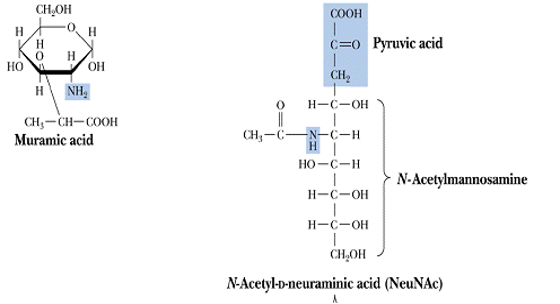A 57 -year-old man has been admitted with congestive heart failure. He has been given Digoxin, which helps the heart to beat more strongly and regularly. Digoxin is an ester that contains a sugar component (glycol) and a nonsugar (aglycone) component attached via oxygen. Digoxin should be best classified as a:
A. Disaccharide
B. Glycoprotein
C. Glycoside
D. Mucopolysaccharide
E. Oligosaccharide
The correct answer is- C- Glycoside.
Digoxin is a cardiac glycoside.
Glycosides are compounds containing carbohydrate and a non-carbohydrate residue in the same molecule. In these compounds, the carbohydrate residue is attached by an acetal linkage of carbon-I- to the non-carbohydrate residue. The non- carbohydrate residue present in the glycoside is called as Aglycone. The aglycones present in the glycosides vary in complexity from simple substances as Methyl Alcohol, glycerol, phenol or a base such as Adenine to complex substances such as sterols, hydroquinones, and anthraquinones. The glycosides are named according to the carbohydrate they contain. If it contains Glucose then it forms Glucoside. If it contains Galactose, then it forms Galactoside, etc.
Glycosides are present in many drugs, spices and in the constituents of animal tissues.
Digitalis is the drug of choice for treating congestive heart failure and arrhythmias. This is a purified glycoside from European foxglove, Digitalis purpurea.
Mechanism of action of Digitalis
The most probable mechanism of action for the positive inotropic effect of digitalis is inhibition of the membrane-bound Na+/K+ -ATPase pump directly which acts as the digitalis receptor; when this occurs, Na+ increases in the cell, the exchange of Na+ for Ca2+ is augmented, and calcium influx is increased. The increased intracellular calcium, in turn, leads to increased release of Ca2+ from the sarcoplasmic reticulum and increased contractility of the cardiac muscle (figure).

Figure showing the mechanism of action of Digoxin.
Changes in the ratio of intracellular and extracellular electrolytes can result in increased automaticity and cardiac arrhythmias. The inhibition of the Na+/K+ -ATPase pump prevents the re-entry of potassium into the cell after the repolarization is complete, leading to depletion of the intracellular potassium. This potassium-depleting action of the digitalis is not confined to the cardiac muscle but also involves the skeletal muscle and the liver. By direct action, it increases the force of contraction of the heart muscle. Digitalis also has a negative chronotropic effect due to decreased conduction velocity in the atrioventricular (AV) node.
Therapeutically it is very useful in heart failure associated with atrial fibrillation and rapid ventricular rate.
As regards other options-
Disaccharides contain two monosaccharides linked together by O- Glycosidic linkage
Glycoprotein contains carbohydrates linked to a protein either O- glycosidic linkage (contributed by OH- a group of Serine or threonine) or by N-glycosidic linkage (contributed by Asparagine).
Mucopolysaccharides are composed of polymerization of a complex of an acid sugar and amino sugar.
Oligosaccharides contain 3-10 monosaccharides linked together by O-glycosidic linkages.




